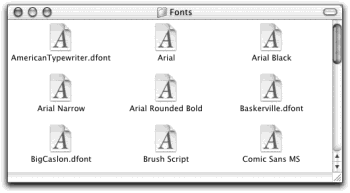Fonts in Mac OS X
Over the years, Macintosh fonts have improved considerably. No longer must you pray to the printer gods that your beautiful flyer won’t come out with jagged-looking type because you chose the wrong font type, one that doesn’t have smooth edges.
Up through Mac OS 9, a family of typefaces called bitmapped fonts was still kicking around, a holdover from the jagged-printing days of the original 1984 Macintosh. But Mac OS X can’t even use such fonts. Only always-smooth font formats work in Mac OS X: namely, TrueType, PostScript Type 1, and OpenType. (OpenType is a font format developed by Microsoft and Adobe that’s already common on Windows machines.)
In short, Mac OS X delivers us fully into the era of type that is all smooth, all the time. Fonts always look smooth onscreen, no matter what the point size, and always look smooth in printouts, no matter what kind of printer you use. Never again will you spend money on programs like Adobe Type Manager just to make your type look smooth.

Figure 13-5. Apple giveth, and Apple taketh away. In Mac OS X, all kinds of fonts are represented by a single icon apiece—a single font suitcase. PostScript fonts no longer require separate files for printer display and screen display. On the other hand, you can no longer double-click a font suitcase to see a preview of what its characters look like, as you could in Mac OS 9.
Where Fonts Live ...
Get Mac OS X: The Missing Manual, Second Edition now with the O’Reilly learning platform.
O’Reilly members experience books, live events, courses curated by job role, and more from O’Reilly and nearly 200 top publishers.

